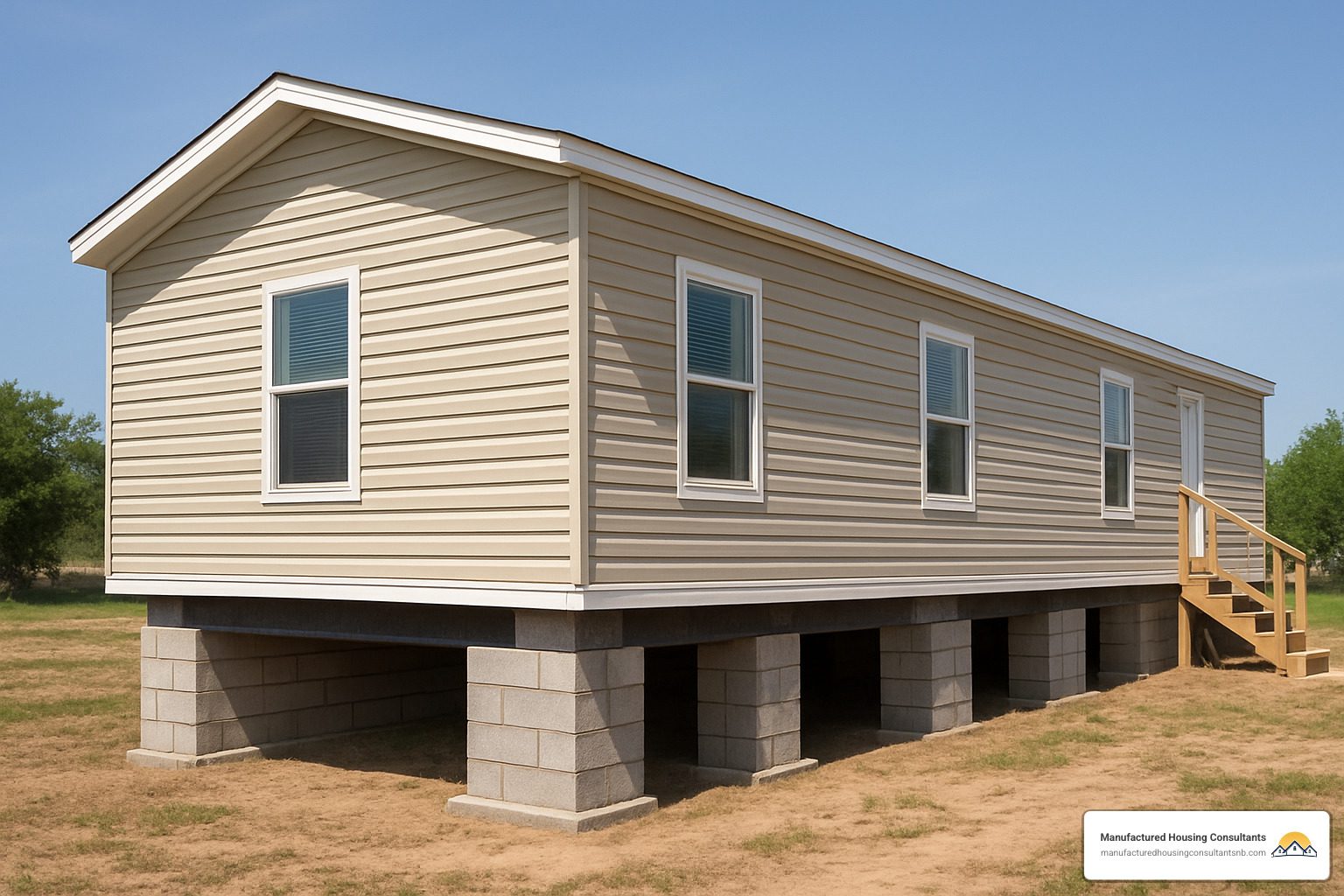All About Mobile Home Foundation Options and Types
Discover mobile home foundation options, costs, and types. Learn how to choose the best mobile home foundation for value and stability.
The Foundation of Your Manufactured Home’s Future
Mobile home foundations are essential support structures that provide stability, protect against environmental damage, and can significantly impact financing options and home value over time.
Here’s what you need to know about mobile home foundation options:
| Foundation Type | Cost Range | Best For | Financing Friendly? |
|---|---|---|---|
| Pier and Beam | $1,000-$2,000 | Budget-conscious buyers, earthquake zones | Limited |
| Slab | $4,000-$9,000 | Flat sites, speed of installation | Yes |
| Crawl Space | $6,000-$15,000 | Uneven terrain, utility access | Yes |
| Basement | $12,000-$25,000 | Adding living space, cold climates | Yes |
| Runner | $2,000-$8,000 | Dry zones, budget options | Limited |
The foundation is truly the unsung hero of any manufactured home. While often overlooked in favor of more visible features like floor plans or finishes, your choice of foundation will determine how your home performs over decades of weather events, soil shifts, and seasonal changes.
“There is no single ‘best’ foundation system,” notes the HUD’s guide to foundation systems. The right choice depends on your specific site conditions, budget, long-term plans, and local building requirements.
Whether you’re buying your first manufactured home, relocating an existing one, or preparing to refinance, understanding your foundation options is crucial. A properly designed and installed foundation can help your manufactured home qualify as “real property” rather than personal property—potentially open uping better financing rates and improving resale value.
The 1974 HUD Manufactured Housing Construction and Safety Standards Act established minimum requirements for manufactured home foundations. Since then, foundation technology has evolved substantially, offering homeowners more choices that balance cost, performance, and long-term value.
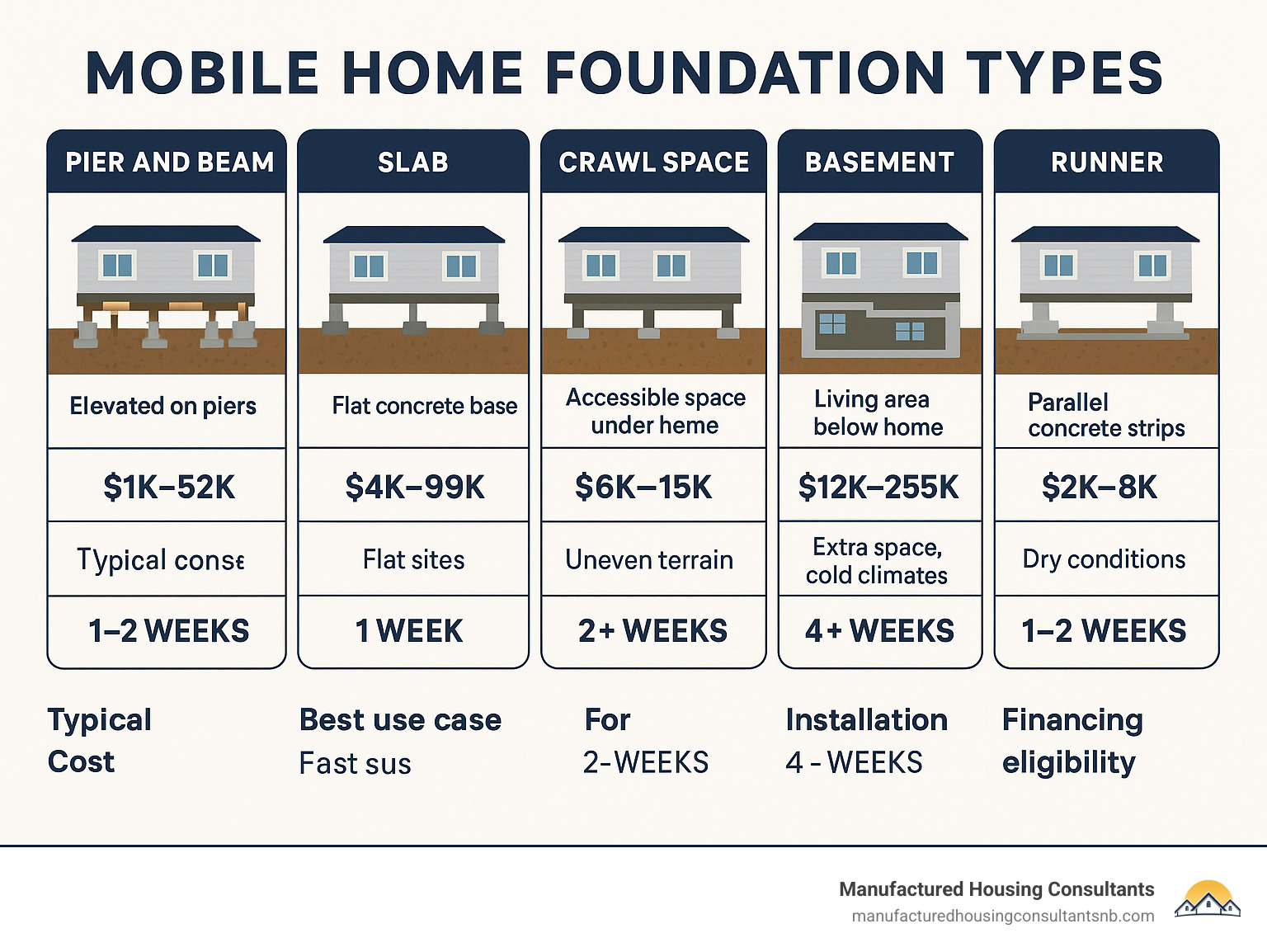
Easy mobile home foundation word list:
Understanding Mobile Home Foundation Basics
What Is a Mobile Home Foundation & Why It Matters
A mobile home foundation is much more than just what sits beneath your manufactured home—it’s the crucial system that transfers your home’s weight safely to the ground while protecting it from nature’s forces. Unlike traditional homes built directly on-site, manufactured homes are constructed in factories and then transported to their final location, where they need a properly prepared foundation waiting for them.
Your mobile home foundation does some pretty important jobs:
It evenly distributes your home’s weight across the soil beneath it, preventing dangerous sinking or tilting. It keeps your home stable during everyday life, so floors don’t bounce and doors don’t stick. During those windy Texas days, it anchors your home firmly against uplift forces that could cause serious damage. It also creates an essential barrier between your home and ground moisture that could lead to rot and mold.
Perhaps surprisingly, your foundation even affects your wallet in a big way—it determines whether your home qualifies for conventional mortgages or better insurance rates.
“The foundation is what transforms a manufactured home from a depreciating asset to a potential appreciating one,” explains John, one of our foundation specialists at Manufactured Housing Consultants. “When we help customers choose the right foundation, we’re not just talking about concrete and steel—we’re talking about their financial future.”
According to research from HUD on moisture control, a properly designed foundation with good ventilation can add years to your manufactured home’s life by preventing moisture problems. The HUD guidelines provide detailed technical requirements that help ensure your foundation will protect your investment for decades.
Permanent vs. Non-Permanent Mobile Home Foundation Systems
When it comes to mobile home foundations, there are two main categories to consider: permanent and non-permanent systems. This distinction affects everything from your financing options to your property taxes and future resale value.
Permanent foundations are built to last, using durable materials like concrete, properly mortared masonry, or pressure-treated wood. They typically include a continuous perimeter support system that fully encloses the underside of your home. With a permanent foundation, your manufactured home can be classified as “real property”—just like a site-built home—which opens doors to conventional mortgages and often more favorable tax treatment.
Non-permanent foundations, on the other hand, consist of removable components like ungrouted blocks or steel piers. They’re generally less expensive upfront and preserve the possibility of moving your home in the future. However, they may limit your financing options and affect how your property is classified for tax purposes.
“When customers ask about non-permanent foundations, I always make sure they understand the trade-offs,” says Maria from our New Braunfels office. “The upfront savings might be appealing, but we want them to consider how it affects their long-term investment.”
The line between permanent and non-permanent isn’t always crystal clear. Different lenders, local building departments, and insurance companies may have their own definitions of what qualifies as “permanent.” That’s why it’s so important to work with experts who understand the specific requirements in your area.
For more details about different foundation types and how they’re classified, check out our comprehensive guide to Mobile Home Foundation Types.
FHA, VA & HUD Compliance for Mobile Home Foundations
If you’re planning to use government-backed financing for your manufactured home, understanding foundation requirements becomes even more important. FHA, VA, and conventional loans that follow HUD guidelines have specific criteria your foundation must meet.
For FHA and VA loans, you’ll need an engineer or architect to certify that your foundation meets HUD requirements. The foundation must be designed to support your home for its full economic life—typically at least 30 years. Your footings need to extend below the local frost line to prevent winter heaving, and in flood zones, the foundation must lift your home above the base flood elevation.
Proper anchoring systems are also required to resist wind forces according to local codes, and your home must be securely attached to the foundation using approved methods.
The HUD Permanent Foundations Guide (HUD-4930.3G) is the definitive resource for compliant foundation design. This detailed document covers everything from soil testing to structural calculations that engineers use to certify your foundation.
“I’ve seen too many homeowners find out too late that their foundation doesn’t meet FHA standards,” notes Carlos, our financing specialist. “It’s heartbreaking to tell someone they can’t qualify for the loan they want because of foundation issues, especially when it could have been avoided with proper planning.”
For homes in earthquake-prone areas, additional requirements apply, including special anchoring systems and reinforced connections. You can learn more about these specialized requirements in the Scientific research on HUD code.
At Manufactured Housing Consultants, we work closely with local engineers and foundation contractors who understand these requirements inside and out. This ensures your foundation not only keeps your home stable and protected but also meets all criteria for your preferred financing option.
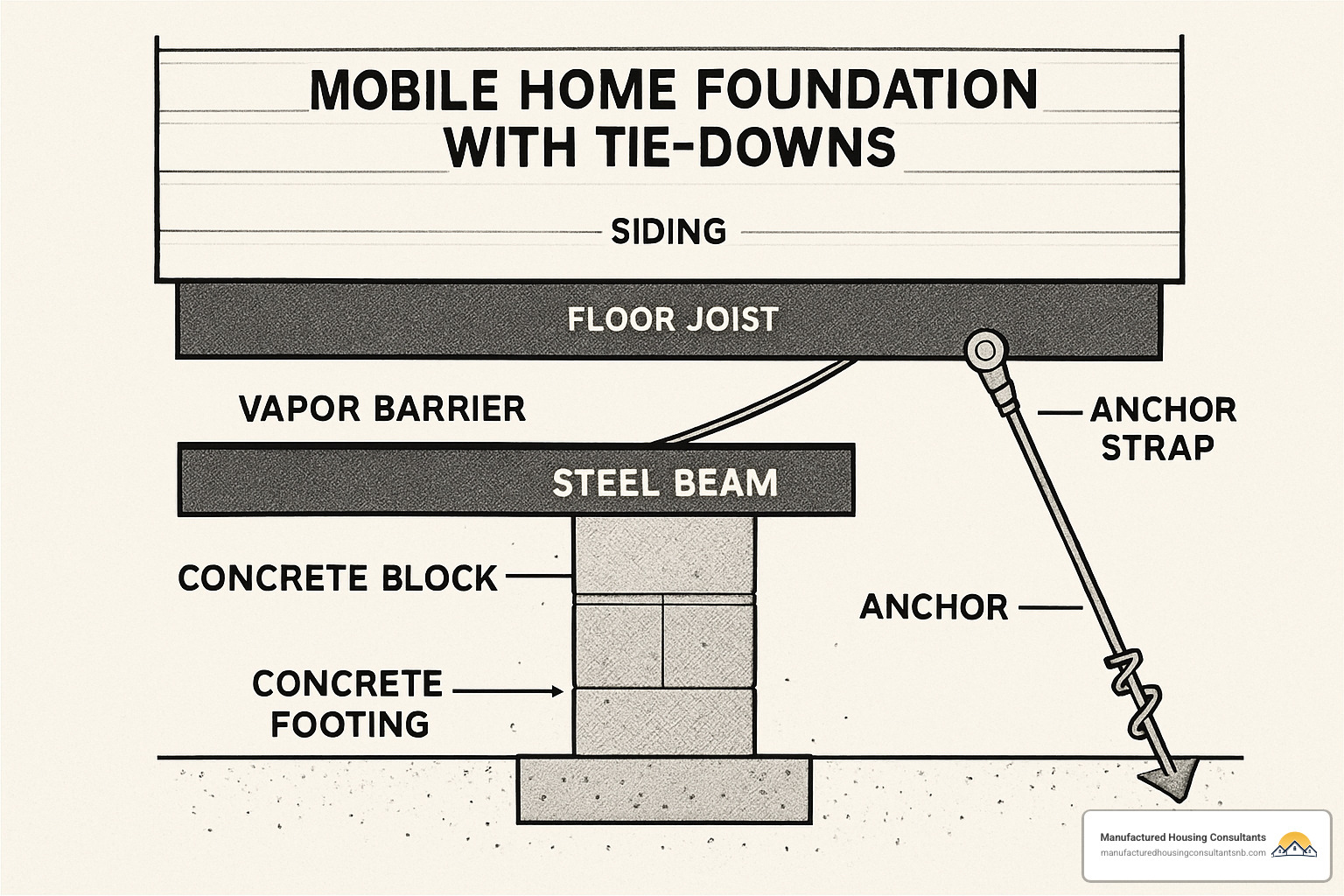
Choosing the Right Foundation Type & Cost Breakdown
Mobile Home Foundation Cost Ranges & Influencing Factors
Let’s talk money – because when it comes to mobile home foundations, your budget plays a major role in what options are available to you.
The price tag for your foundation can vary dramatically based on what you choose and where you live. A basic pier-and-beam setup might run you as little as $1,000, while a full basement foundation could climb to $25,000 or more. That’s quite a range!
“I always tell folks to think about their foundation as an investment, not just an expense,” says Robert, our site preparation specialist. “The foundation you choose today affects everything from your home’s longevity to its resale value years down the road.”
Several key factors will influence what you’ll end up paying:
Your home’s size makes a big difference – a double-wide typically needs 60-100% more foundation materials than a single-wide. The soil on your property matters too; poor soil conditions might require additional work, potentially increasing your costs by 15-30%.
If your lot isn’t flat, prepare for additional expenses. Sloped sites need more preparation and sometimes retaining walls, which can add $2,000-$10,000 to your project. Local building codes vary widely across Texas and can significantly impact what materials you’ll need and how much labor will cost.
Climate considerations also play a role. In areas prone to freezing, you’ll need frost protection. In flood-prone regions, elevation requirements will affect your foundation design and cost.
Here’s a helpful breakdown of typical foundation costs:
| Foundation Component | Typical Cost Range | Notes |
|---|---|---|
| Site Preparation | $1,000-$5,000 | Includes clearing, grading, excavation |
| Footings | $1,000-$3,000 | Depends on soil conditions and frost depth |
| Concrete Materials | $1,500-$8,000 | Varies by foundation type and home size |
| Labor | $2,000-$10,000 | Higher for complex systems like basements |
| Permits & Inspections | $500-$2,000 | Varies widely by location |
Before finalizing your foundation budget, I’d recommend getting a professional soil test ($300-$1,000), checking local frost depth requirements, talking with your lender about their foundation requirements, and collecting quotes from at least three qualified contractors.
At Manufactured Housing Consultants, we can help you steer these considerations and connect you with reputable foundation contractors in the New Braunfels area who won’t break the bank.
Pier-and-Beam, Slab, Runner, Pit & Basement: Pros and Cons
Each mobile home foundation type comes with its own set of advantages and trade-offs. Let’s break them down so you can find the perfect match for your situation.
Pier-and-Beam Foundation

The pier-and-beam system is the most budget-friendly option, usually running between $1,000-$2,000. Many of our customers love that it can be installed in just one day. It’s particularly good in earthquake-prone areas because it offers some flexibility during ground movement.
Need easy access to plumbing or electrical? Pier-and-beam gives you that accessibility. It also works beautifully on sloped sites and allows for air circulation underneath your home, which can prevent moisture problems.
The downsides? You’ll likely need to re-level your home more frequently than with other foundation types. It also offers less protection from pests and moisture, and may limit your financing options since some lenders prefer more permanent foundations.
Slab Foundation
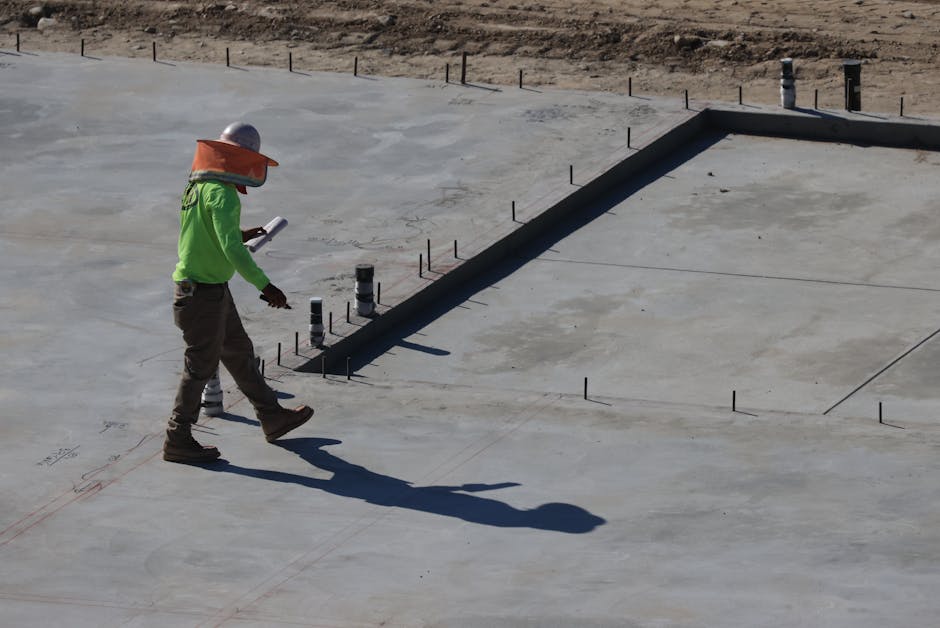
A concrete slab is the middle-of-the-road option cost-wise ($4,000-$9,000) but offers excellent stability on level sites. One of the biggest advantages is that it qualifies for most financing programs, which can save you money in the long run through better interest rates.
Many homeowners appreciate that a slab foundation reduces pest concerns and requires very little maintenance. With proper insulation, it’s also quite energy efficient.
The drawbacks? Accessing plumbing becomes much more difficult if repairs are needed. Slabs aren’t ideal for sloped sites, and they can crack in areas with expansive soils. And if you ever want to move your home, a slab makes that nearly impossible.
Runner Foundation
Runner foundations strike a nice balance, costing between $2,000-$8,000. They’re particularly well-suited for dry climates and offer easier utility access than full slabs while providing better stability than pier-and-beam systems.
The installation is faster than a full slab, which means less waiting time before your home can be set. However, they’re not ideal in very wet or seismically active areas. The limited ventilation can create moisture issues if not properly designed, and some financing programs may not accept this foundation type.
Pit/Crawl Space Foundation
At $6,000-$15,000, a crawl space foundation costs more than simpler options but offers significant benefits. It provides excellent access to utilities while qualifying for most financing programs. Many homeowners appreciate that it gives their manufactured home a more site-built appearance.
Crawl spaces work well on sloped lots and provide good moisture protection when properly ventilated. The main disadvantages are the higher cost, the need for proper ventilation to prevent moisture issues, and the more complex construction process.
Basement Foundation
The basement foundation is the premium option at $12,000-$25,000, but it adds valuable living or storage space to your home. It maximizes property value and provides the highest qualification for financing.
In cold climates, a basement offers excellent protection from freezing, and in severe weather areas, it can serve as a storm shelter. It makes your manufactured home most similar to site-built homes, which can be advantageous for resale.
The obvious downside is the cost, along with the lengthy installation time. Basements require careful waterproofing and aren’t suitable for areas with high water tables.
“I always tell customers to think about how long they plan to stay in the home,” says Jennifer, our sales consultant. “If it’s your forever home, investing in a basement or crawl space foundation often makes sense. If you might relocate in a few years, a pier-and-beam system might be more practical.”
One of our customers, Michael from San Antonio, shared his experience: “We initially wanted to save money with a pier-and-beam foundation, but after discussing our financing plans with Manufactured Housing Consultants, we opted for a crawl space instead. It cost about $8,000 more, but we qualified for a conventional mortgage with a better interest rate, saving us thousands over the life of the loan.”
Special Cases: Single-Wide, Double-Wide, Modular, ADU, Park Model & Glamping Pod Foundations
Different types of manufactured housing have unique foundation needs based on their size, weight, and intended use. Let’s look at what makes each one special.
Single-Wide Manufactured Homes typically need simpler foundations because they’re lighter and have a smaller footprint. With foundation costs ranging from $1,000-$12,000 depending on the type, many single-wide owners opt for pier-and-beam or runner foundations. These homes usually weigh about 35-40 pounds per square foot and have a single marriage line for utilities that needs to be considered in the foundation design.
Double-Wide Manufactured Homes are heavier and larger, requiring more substantial foundations. Expect to spend $2,000-$25,000 on a foundation for a double-wide. These homes benefit from slab or crawl space foundations and typically weigh 40-45 pounds per square foot. The marriage line where the two sections join requires precise leveling to ensure proper alignment – even a small discrepancy can cause problems with doors, windows, and roofing.
Modular Homes need permanent foundations similar to site-built homes, with costs typically ranging from $6,000-$25,000. Unlike manufactured homes that follow HUD code, modular homes must meet local building codes. They’re designed to attach permanently to foundations and commonly use crawl space, slab, or basement foundations.
Accessory Dwelling Units (ADUs) often have size-specific foundation requirements and typically use pier-and-beam or slab foundations costing $6,000-$20,000. These smaller living spaces may have special zoning requirements that affect foundation design. Space-saving foundation designs are often beneficial for ADUs since they’re typically built on limited lot space.
Park Model Homes are designed for recreational or seasonal use and are often placed on gravel pads or pier foundations. With foundation costs averaging $2,220-$4,059, these homes under 400 square feet may have specific tie-down requirements due to their potentially temporary nature. They’re often designed with the possibility of relocation in mind.
Glamping Pods and Tiny Homes are lightweight structures with minimal foundation needs, typically using simple gravel pads or pier systems. Foundation costs are usually between $975-$2,106. These unique structures may be exempt from some building codes but still need to consider stability and anchoring, especially in windy areas.
“The key with specialized units like park models or ADUs is understanding both the structural requirements and the regulatory landscape,” explains Thomas, our zoning specialist. “Different jurisdictions have varying requirements for these unique housing types, which can affect your foundation options.”
We recently helped a customer setting up a glamping pod business in the Hill Country. They initially planned to use simple gravel pads but finded their insurance provider required more substantial anchoring due to wind concerns. We helped them design a modified pier system that satisfied the insurance requirements while maintaining the aesthetic they wanted.
For more information about financing these different housing types, visit our Introduction to Mobile Home Financing.
Site Prep, Drainage & Long-Term Maintenance Tips for Your Mobile Home Foundation
The best foundation in the world won’t perform well without proper site preparation, drainage planning, and ongoing maintenance. These elements are crucial for ensuring your mobile home foundation stands the test of time.
Good site preparation starts with thoroughly clearing and leveling your building area. Remove all vegetation, debris, and topsoil from where your foundation will sit. Conduct proper soil tests to understand what you’re building on – this small investment (typically $300-$1,000) can prevent major headaches down the road.
Proper grading is essential – create a slight slope away from your foundation area, typically about 6 inches of fall over 10 feet. This simple step helps water move away from your home rather than pooling around it. Don’t skip soil compaction either; properly compacted soil prevents future settling that could damage your foundation.
“I’ve seen too many foundation problems that could have been prevented with proper site preparation,” notes Carlos, our site prep specialist. “Spending a little more time and money upfront can save thousands in repairs later.”
Drainage is your foundation’s best friend – and poor drainage is its worst enemy. Consider these drainage solutions for your property:
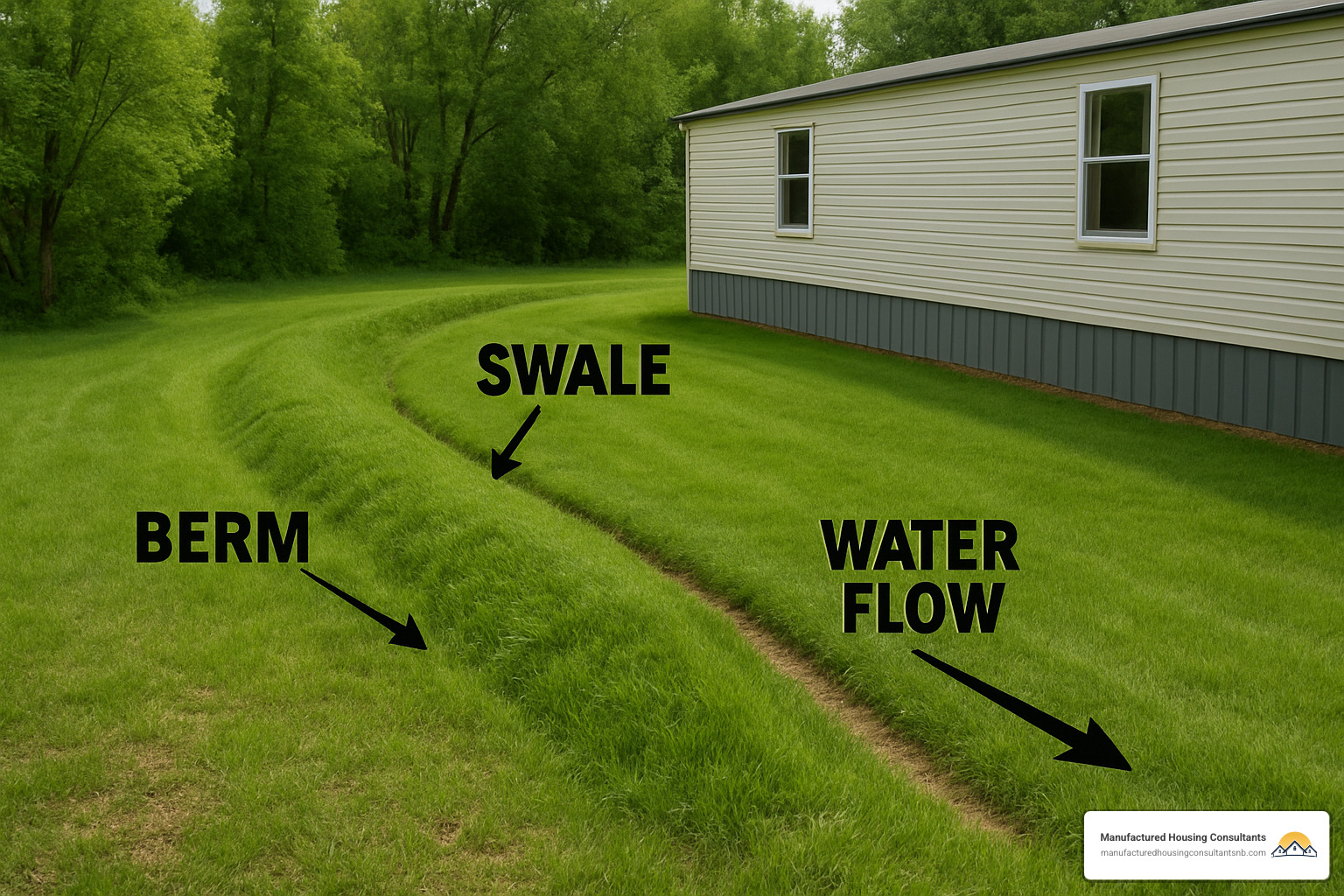
French drains (gravel-filled trenches with perforated pipes) can effectively direct water away from your foundation. Swales and berms – landscaped depressions and raised areas – channel water flow naturally. Don’t underestimate the importance of gutters and downspouts in directing roof runoff away from your foundation.
In areas with high water tables, a sump pump might be necessary. Gravel curtains around your foundation perimeter can significantly improve drainage. Above all, maintain proper grading with a slope away from your home on all sides.
Once your home is set, regular maintenance becomes essential. Check your foundation at least twice yearly and after severe weather events. Most manufactured homes need re-leveling every 3-5 years – it’s normal for some settling to occur over time.
For moisture control, maintain proper crawl space ventilation and vapor barriers. Keep your skirting in good repair, ensuring it has proper ventilation and access points. In areas where termites are a concern, install and maintain termite shields. Regularly clean gutters and maintain proper drainage slopes away from your home.
A customer from New Braunfels shared this experience: “After our first heavy rain, we noticed water pooling near our foundation. The team at Manufactured Housing Consultants helped us design a simple swale system that directed the water away from the home. It was an inexpensive fix that potentially saved us from serious foundation issues.”
If you have a pier-and-beam foundation, check pier alignment annually and ensure proper ventilation through skirting (1 square foot of vent area per 150 square feet of floor area). Install a 6-mil polyethylene vapor barrier on the ground and keep the area under your home free of debris and vegetation.
For slab foundations, inspect for cracks annually, maintain proper drainage away from the slab edges, seal any joints between the home and foundation, and monitor for signs of settling or heaving.
Even the best foundation can fail without proper maintenance. A small investment in regular upkeep can prevent costly repairs and extend the life of your manufactured home – protecting both your comfort and your investment.
Conclusion & Next Steps
Selecting the right mobile home foundation is truly one of life’s bigger decisions when you’re investing in manufactured housing. This choice touches everything – from how stable your home feels during a thunderstorm to whether you’ll qualify for that dream mortgage rate.
Here at Manufactured Housing Consultants in New Braunfels, we’ve guided hundreds of Texas families through this exact decision. We know it can feel like information overload at first! That’s why our team takes the time to understand your specific situation before recommending foundation options that make sense for your budget, property, and future plans.
Let’s quickly recap what we’ve explored together:
We’ve examined foundation types ranging from budget-friendly pier-and-beam systems (starting around $1,000) to value-boosting basements (which can run up to $25,000). Each offers its own blend of benefits and considerations.
We’ve unpacked the regulatory requirements from FHA, VA, and HUD that directly impact your financing options. (Trust us – understanding these requirements before you build can save major headaches later!)
We’ve looked at how your specific property conditions – everything from soil type to whether you’re on a hillside – influence which foundation will perform best over decades.
And perhaps most importantly, we’ve discussed how investing in a permanent foundation can transform your manufactured home from “personal property” into “real property” – potentially adding thousands to its value over time.
“I like to tell customers that your foundation choice is a bit like choosing good tires for your car,” says Michael, our senior consultant. “It’s not the flashy part that visitors notice first, but it affects literally everything about how your home performs and holds its value. Getting it right from day one just makes sense.”
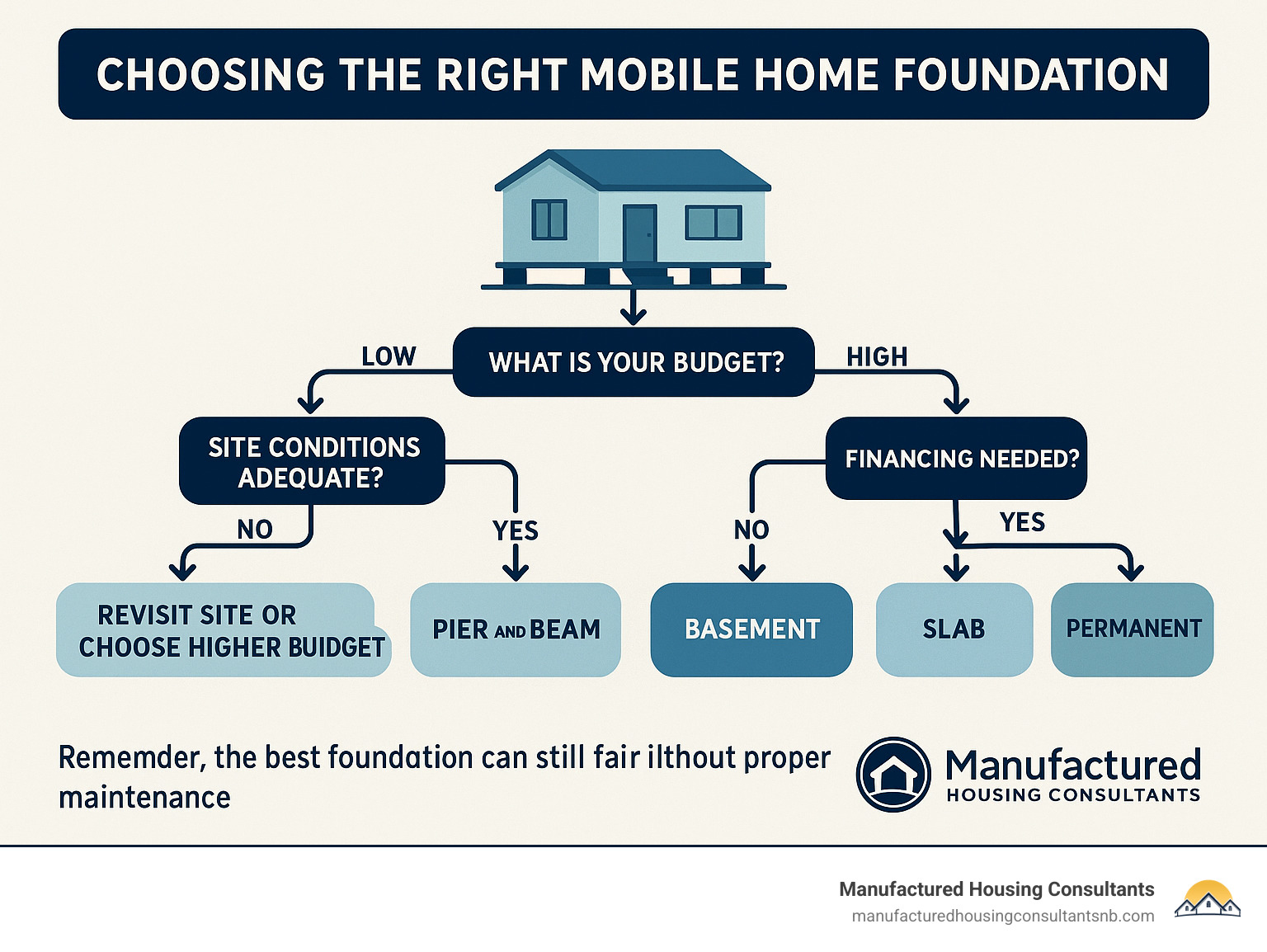
Where to go from here:
First, take some time to truly understand your property. Walk your land after a heavy rain. Notice where water pools. Is your soil sandy or clay-heavy? These observations matter tremendously.
Next, get clarity on your financing direction. Different loan programs have different foundation requirements – knowing which program you’ll likely use helps narrow your foundation options.
Then, give us a call! Our team loves talking through these decisions. We can help match your specific situation with foundation options that make sense for your budget and goals.
After our consultation, we recommend getting quotes from at least three reputable foundation contractors. We’re happy to connect you with professionals we trust in the New Braunfels area.
Finally, consider your future plans. Do you see this as your forever home? Or might you want the flexibility to relocate in five years? Your timeline affects which foundation investment makes the most sense.
Whether you’re excited about a brand-new manufactured home from one of our eleven trusted manufacturers, or looking to improve the foundation on your existing home, we’re here to guide you through each step.
For those interested in our selection of quality manufactured homes, including popular options from Jessup Housing, check out our Jessup Housing page.
Remember – the right mobile home foundation doesn’t just support your house. It supports your dreams of affordable, quality homeownership for years to come. And helping those dreams become reality is exactly why we love what we do at Manufactured Housing Consultants.

